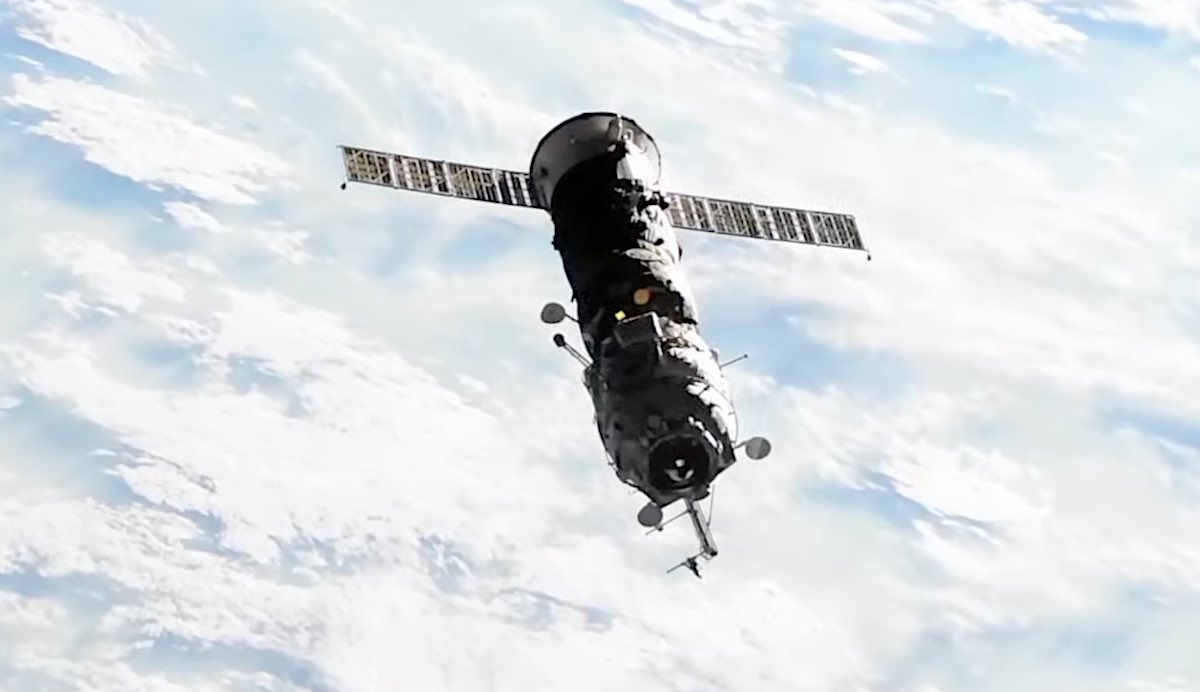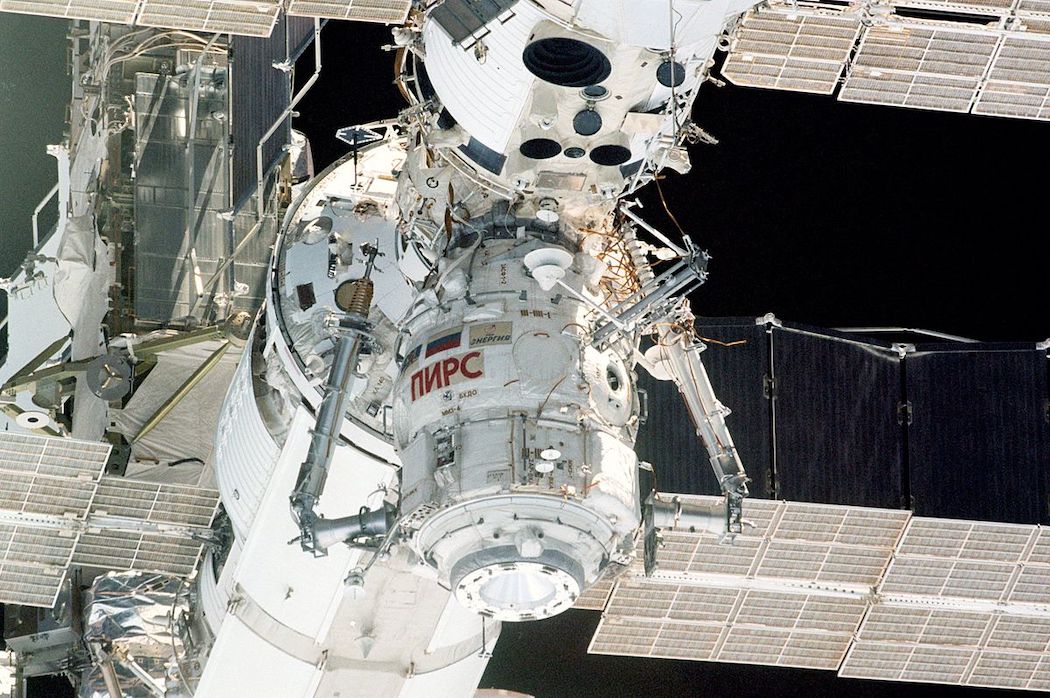EDITOR’S NOTE: Updated at 12 p.m. EDT (1600 GMT) after re-entry.

Wrapping up nearly 20 years of service as a docking port and airlock, Russia’s Pirs module departed the International Space Station Monday under tow from a Progress supply ship and headed for a destructive re-entry in Earth’s atmosphere, clearing the way for arrival of a larger science lab later this week.
Russia’s Progress MS-16 cargo freighter undocked from the space station at 6:55 a.m. EDT (1055 GMT) Monday as the outpost soared 260 miles (418 kilometers) over northern China.
Instead of departing the station alone, the Progress spacecraft backed away from the complex with Russia’s Pirs docking compartment, clearing a port on the Zvezda service module that has been occupied since 2001.
The Pirs module launched to the space station Sept. 14, 2001, aboard a Soyuz rocket from the Baikonur Cosmodrome in Kazakhstan. A modified Progress cargo spacecraft delivered the Pirs module to the station, culminating in a docking with the Earth-facing port on the Zvezda service module two days after launch.
Since then, the Pirs module supported 52 spacewalks and served as a docking port for Russian Soyuz and Progress ferry ships carrying crew and cargo to the space station. The Russian Poisk module, launched in 2009 and similar in design to Pirs, remains at the space station on the opposite side of the Zvezda module to serve as an airlock for future Russian spacewalks.
Poisk, like Pirs, also doubles as a docking port for visiting Russian crew and cargo ships. Soyuz and Progress spacecraft can also dock with Russia’s Rassvet module, the rear port of the Zvezda module, and will be capable of connecting with the Nauka science laboratory set to take the place of Pirs on the space station later this week.
U.S. crew and cargo vehicles have their own docking ports on the opposite end of the space station.
Russia’s Pirs module detached from the International Space Station at 6:55am EDT (1055 GMT) over China, clearing a docking port on the Zvezda service module for the first time since 2001.
Russia’s new Nauka science lab is set to dock there Thursday.https://t.co/lYliaJtblF pic.twitter.com/w0Ka92aw9H
— Spaceflight Now (@SpaceflightNow) July 26, 2021
The Progress MS-16 cargo freighter became the final visiting vehicle to dock with Pirs in February. On June 2, cosmonauts Oleg Novitskiy and Pyotr Dubrov ventured outside the space station to prep the Pirs module for disposal. Their tasks included repositioning an extendable tethered to Pirs, and unplugging rendezvous antenna cables from the module.
Pirs, which means “pier” in Russian, measures about 16 feet (4.9 meters) long and 8.4 feet (2.55 meters) in diameter at its widest point, according to NASA.
With those preparations complete, Russian officials awaited launch of the module that will replace at Zvezda’s Earth-facing docking port.
The Nauka science lab, a long-delayed expansion of the space station’s Russian segment, launched last Wednesday from Baikonur aboard a Proton rocket. After working through post-launch problems with the new spacecraft’s propulsion system and Kurs automated rendezvous radar, Russian mission controllers finally completed the first orbital maneuvers with Nauka’s main engines over the weekend and verified the Kurs system was functional for the science lab’s docking with the space station.
While ground teams worked through those issues, Russian managers delayed the departure of the Pirs module from Friday until Monday to get a clearer picture of the status of the new Nauka spacecraft.
Satisfied the the Nauka module is on track to arrive at the space station Thursday, mission control in Moscow gave the go-ahead to depressurize the docking system connecting Pirs with Zvezda in preparation for the departure Monday.

After undocking, the Progress MS-16 spacecraft fired thrusters to carry the Pirs module a safe distance from the space station. That set the stage for a nearly 18-minute deorbit burn at 10:01 a.m. EDT (1401 GMT) Monday to guide the Progress spacecraft, loaded with trash from the space station, and the Pirs module into the Earth’s atmosphere for a destructive re-entry less than an hour later.
Russia’s space agency, Roscosmos, said any debris that survived the scorching hot re-entry fell into a remote stretch of the South Pacific Ocean between New Zealand and Chile around 10:51 a.m. EDT (1451 GMT).
With Pirs out of the way, ground teams planned to inspect the Earth-facing docking port on the Zvezda module later Monday using cameras on the the space station’s Canadian-built robotic arm. The seven-hour video inspection will ensure there’s no debris or obstructions on the docking mechanism, which was last used for a docking when Pirs linked up with the station in 2001.
If teams find any problems, cosmonauts Oleg Novitskiy and Pyotr Dubrov could head outside the space station on a spacewalk later this week to clean up the docking system.
The Nauka module is set to dock with the space station Thursday at 9:24 a.m. EDT (1324 GMT).
After docking of the Nauka module, Russian cosmonauts plan a series of up to 11 spacewalks later this year and early next year to outfit the exterior new lab element.
The Progress cargo ship carrying the Pirs module away from the International Space Station completed a burn to depart the vicinity of the complex.
That sets the stage for a deorbit burn at 10:01am EDT (1401 GMT), soon followed by a destructive re-entry.https://t.co/lYliaJtblF pic.twitter.com/FUNwjggMRT
— Spaceflight Now (@SpaceflightNow) July 26, 2021
Once fully operational, Nauka will accommodate dockings of Progress resupply ships, Soyuz crew capsules, and Russia’s new Prichal node module later this year.
Inside Nauka, Russian cosmonauts will install and activate scientific experiments, prepare a new oxygen generation system for operation, set up a new toilet, and ready a new sleeping compartment for an extra Russian crew member on the space station.
The Nauka module, also called the Multipurpose Laboratory Module, carries the European Robotic Arm, which was completed 15 years ago to await an opportunity to fly to the space station.
At 20.2 metric tons (44,500 pounds), the Nauka module is more than five times the mass of the Pirs docking compartment. Nauka extends about 43 feet (13 meters) long, which will make it one of the largest modules at the International Space Station.
The bus-sized Nauka research module has been in development for more than 20 years, originally as a backup for Russia’s Zarya module, the first element of the space station to launch in 1998. Russia said in 2004 that the backup to Zarya would be converted into a lab module for launch in 2007.
But delays have kept the Russian lab on the ground for years. Engineers at Energia, the prime contractor for Russia’s human spaceflight program, found flaws in the module’s propulsion system in 2013. The module was returned to Khrunichev, its manufacturer, for lengthy repairs that delayed Nauka’s launch several more years.
Nauka is the first pressurized module to be added to the space station since the arrival of the small Bigelow Expandable Activity Module in 2016. The last Russian pressurized element of any size launched to the space station was the Rassvet docking module, which was delivered by a NASA space shuttle in 2010.
Email the author.
Follow Stephen Clark on Twitter: @StephenClark1.
